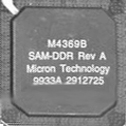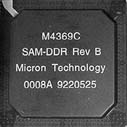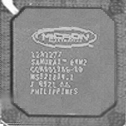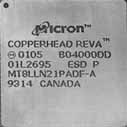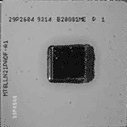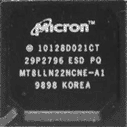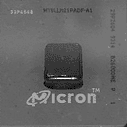Micron Semiconductor [PCI vendor ID 1042]
Micron Technology Inc [PCI vendor ID 1344]
Crucial, a subsidiary of Micron Technology [PCI vendor ID C0A9]
owner of Crucial Technology
owner of PCTech
Micron Semi / Tech is NOT to be mixed with Micron Electronics Inc aka Micron PC or MPC.
Micron Semi / Tech was founded privately in Nampa, Idaho, in 1995 through a merger of ZEOS International, Micron Computer, and Micron Custom Manufacturing
|
|
|
|
|
||||||||||||||||||||||||||||||||||||||||||||||||||||||||||||||||||||||||||||||||
|
|
|||||||||||||||||||||||||||||||||||||||||||||||||||||||||||||||||||||||||||||||||||
Samurai
Samurai
M???? Northbridge (Slot1 x86, 32bit/64bit 66MHz PCI, 8DIMM)
Southbridge typically VIA VT82C586B
Samurai 64M2
MT82P664 Northbridge (Slot1 x86, 32bit/64bit 66MHz PCI, 8DIMM, LAN)
Southbridge typically intel PIIX4e
Northbridge Samurai M4369B
[1042.1000] PC Tech RZ1000, 37C655 Floppy + IDE controller
[1042.1001] PC Tech RZ1001, 37C922
Samurai SL, Samurai w/ support for SLDRAM (P6, FSB100/133, PC266 SLDRAM, 64Bit 66MHz PCI, Socket X interface)
Socket X: standard for GPU socket allowing flexibility to add OEM graphics core, Rendition core
Samurai DDR, Samurai w/ support for DDR RAM (P6, FSB100/133, DualCPU, PC266 DDR SDRAM, AGPx4, 64Bit 66MHz PCI)
[1042.3000] Samurai device 0 'Host-PCI bridge'
[1042.3010] Samurai device 1 'Memory Controller'
[1042.3020] Samurai IDE
Previous chipsets withdrawn from market due to claim by intel on AGTL+ license violation.
Micron reportedly licensed the Samurai design to VIA
MT8LLN21PADF 'Copperhead' Northbridge, Host Controller, 2x intel PIII (80533 / 80530), max 8GB DDR SDRAM, PCI-X 66/100/133MHz, 64bit PCI 2.2 33MHz, DualCPU
[1344.3240] CopperHead CopperTail SC1 AMC AC97
[1344.3320] Host-PCI bridge
[1344.3321] Memory Controller
[1344.3330] PCI-PCI bridge
Stepping A0 = RevID 01h, Stepping A1 = RevID 02h, Stepping A2 = RevID 03h
MT8LLN22NCNE 'Coppertail' Southbridge, Peripheral Bus Controller, ATA-100, 4x USB 1.1, SMbus, I/O APIC, LPC
[1344.3470] LPC and Legacy System Controller
[1344.3471] SMBus Controller
[1344.3472] IDE Controller
[1344.3473] USB Controller
Stepping A0 = RevID 00h, Stepping A1 = RevID 01h, Stepping A2 = RevID 02h, Stepping A3 = RevID 03h
'Mamba', Northbridge, K7 chipset w/ DDR support, 8MB embedded DRAM L3, no final production launch
'Scimitar', P4, Northbridge, DDR SDRAM, 8MB embedded DRAM L3, no final production launch
[1344.4020] CopperHead CopperTail SC1 IDE Controller
[1344.4030] CopperHead CopperTail SC1 USB Controller
'Shogun', P4, Northbridge, DDR SDRAM, 8MB embedded DRAM L3, integrated Rendition video, no final production launch
Licensing discussion with intel on Pentium 4 bus license failed in 2001.
In 2002 Micron sold their dual DDR channel chipset to Intel, and stopped developing chipsets.
Micron PCIe SSDs
[1344.5150] RealSSD P320h
[1344.5151] RealSSD P320m
[1344.5152] RealSSD P320s
[1344.5153] RealSSD P325m
[1344.5160] RealSSD P420h
[1344.5161] RealSSD P420m
[1344.5163] RealSSD P425m
BACKGROUND (refer to EEtimes, Jack Robertson 10/15/1999):
Hoping to stimulate sales of higher-speed memory, Micron Technology Inc. said it may put its double-data-rate, SDRAM-enabled Samurai chipset out for license to accelerate the market's adoption of PC266 DDR devices.
Dean Klein, vice president of the integrated-products group at Boise, Idaho-based Micron, said the company "isn't in the chipset business, but [wants] to enable the early penetration of DDR memory into the market." Klein said widespread availability of DDR chipsets is the gating function to ramping up PC266 sales.
The first large-scale application of DDR will be in PC servers, according to Klein, although many server OEMs are developing their own DDR chipsets and aren't likely to license Micron's Samurai technology, he added. "We've already worked with these OEMs closely and discussed much of our Samurai DDR concepts," he said. "The important thing for us isn't what technology they use, but getting DDR chip-sets into the market to allow Micron to sell PC266 and PC2100 DDR modules."
The Samurai DDR is the latest high-speed version of a device family that was first developed to support the workstation computer line of OEM affiliate Micron Electronics Inc., Nampa, Idaho. The Samurai SL was later developed to support SLDRAM, which Micron was promoting as an alternative to Direct Rambus DRAM. The SLDRAM effort was dropped, but its SSTL (stub series terminated logic) technology is being used in the Samurai DDR chipset, according to Klein.
SSTL is needed in the new DDR chipset to reduce the effects of noise and crosstalk on the memory bus, and replaces the traditional VLTTL (very-low-voltage transistor-transistor logic) of standard SDRAM chipsets. Micron believes the first servers to use DDR memory will enter the market in early 2000, making for a steep ramp of PC266 chips through the rest of the year.
Even sooner, perhaps by the end of this year, Klein said, point-to-point DDR SDRAMs operating at 300 MHz or more will be adopted by graphics-board suppliers for use as dedicated frame-buffer memory. Dedicated chips can operate at higher speeds because graphics memory doesn't have to adhere to the many additional specifications required for PC266 main memory, according to the company.
While Micron is pushing DDR SDRAM, it is also developing 128-Mbit 700- and 800-MHz Direct Rambus. The memory would be supported by Intel Corp.'s twice-delayed Camino chipset, which is now expected to ship sometime later this quarter. "Micron is eager for Intel to solve the Direct RDRAM bus-line-memory data-loss problem" that caused the latest delay, Klein said. Even so, the schedule slip has helped Micron, which wasn't trying to be among the first Direct RDRAM producers, by allowing it to catch up with some of the market's early adopters.
Klein said one advantage of Direct RDRAM is its lower pin count. He believes DDR SDRAM and Direct Rambus will initially address different applications.
